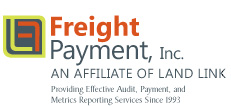Case Study
Client
Major manufacturer and wholesaler of small appliances that maintains multiple shipping facilities throughout the continental US, Canada, Mexico, and Europe. Client utilizes nearly every mode of transportation and carrier type including steamship and air.
Organizational Objectives
- Streamline the freight bill audit and payment process and create efficiency.
- Establish a single audit function that will effectively process all shipment types.
- Initiate a process that will resolve audit exceptions.
- Create an internal control and reporting process that will insure that warehousing staff is routing outbound freight in a compliant manner within the context of the TMS (Transportation Management System) in order to optimize transportation costs.
- Provide support to the accounting department respective of transportation charges.
- Establish a powerful database and set of measurements and reports needed to drive sound business decisions at the consignee and product type levels. In addition, provide the needed data to support the carrier RFQ process.
Streamlining the audit and payment processes, provide processing support for all shipment types, and resolve audit exceptions.
The Challenge
When Freight Payment Inc. first introduced itself to the client, the client was manually reviewing and processing hundreds of hardcopy carrier invoices each month. Given the fact that the client was utilizing the services of more than ten different asset based carriers covering all modes of transportation and each with its unique tariff agreements and rate structures, the existing process was ineffective. The client was processing overcharges, on a routine basis, to nearly all carriers. In addition, the associated workload and burden being placed on internal staff within both the operations and accounting departments was unacceptably high. In addition, internal processing costs could not be justified especially given the fact that results were poor.
The Solution
In order to achieve the intended objectives, Freight Payment Inc. initiated the following actions.
The first step in the process required that Freight Payment Inc. obtain all in force carrier pricing agreements from the client. This included the pricing extended by all carrier types including small parcel, domestic ground (LTL, Volume, and Truckload carriers) as well as the agreements that had been established with the various steamship lines used to support import activity. Once obtained, Freight Payment Inc. loaded all of the rate structures into its audit system including effective and expiration dates, fuel surcharge matrices, accessorial charge tables, etc. As a side note, Freight Payment Inc. was responsible for all ongoing maintenance.
The second step in the process was to review the specific audit rules with the client. Freight Payment Inc. worked with the client to complete the "Business Rules Questionnaire" which outlined the specific rules governing audit processing such as transactional matching criteria, tolerances, weekly closing schedule, general ledger coding, etc. Once completed, the client specific business rules were established within the audit system.
The third step taken was for Freight Payment Inc. to establish the EDI210 transaction set with all carriers in order to receive and process carrier invoicing electronically, thereby improving efficiency and accuracy through the elimination, or at least, minimization of manual data entry. For those carriers that could not participate in EDI 210 or where volumes did not justify establishment on behalf of the carrier, Freight Payment Inc. initiated the support of its data entry staff to support manual data entry as needed.
In addition, Freight Payment Inc. assisted the client with the implementation of a Bill of Lading file download used to enhance the audit process and to drive metrics reporting. Although not required, the Bill of Lading was recommended and certainly needed in order to support the intended metrics reporting that the client desired.
Finally, as it was the desire of the client to rid itself of the tremendous effort needed to investigate and resolve all audit exceptions, Freight Payment Inc. assigned exception resolution responsibilities to its experienced staff.
The Result
As a result of the actions taken above, the client was able to completely outsource the audit and payment process, eliminate the use of internal resources that were being consumed at the time, and most of all receive the benefit of 100% audit of all carrier charges down to the penny thereby completely eliminating the occurrence of carrier over payments. In addition, the accounts payable department was also benefited. Instead of processing hundreds of carrier invoices and remittances each month, they now only needed to process one concise statement per week. Funds were wired to Freight Payment Inc. who then processed all of the individual checks and remittance advices to all of the carriers on a weekly basis.
Routing Compliance
The Challenge
While the client did utilize an effective routing tool on the front end to assign shipments to carriers predicated upon least cost, management was concerned that, at times, the warehousing staff in the various remote facilities might, on occasion, deviate from the recommended routings assigned by the TMS (Transportation Management System). Certainly they had no true visibility to this activity at the shipment level and were not able to match front-end routing decisions to the carrier invoices that were being received and processed for payment. The overall impression was that dollars were being wasted and the bottom-line was being negatively impacted due to routing non-compliance.
The Solution
The audit process was used to support an ongoing routing compliance metric that was subsequently used by management to understand the level of and financial impact related to routing non-compliance on behalf of their operational staff. The client was provided with the "Least Cost Carrier Not Used" report on a weekly basis. Because Freight Payment Inc. was already being provided with a download of the Bill of Lading file produced by the TMS, it was in a position to have knowledge of the specific carrier assigned by the TMS to each specific shipment. By matching the Bill of Lading against the carrier invoice, inappropriate carrier utilization could be identified and excess cost calculated on a per shipment basis. This formed the basis of the report submitted to the management team each week.
The Result
Because management now had the visibility that they needed, they were now in a position to review results with their operational staff and question individual shipments relative to actual versus planned routing. The result was that such deviations were dramatically reduced over time and the associated negative cost impact mitigated.
Reporting frequency and format was determined by the client. Today, we provide the client with hard-coded reports, data files for their own use, as well as ad-hoc analysis.
Metrics include:
- Freight cost per cube, per pound, and per piece
- Freight cost as a percentage
of revenue - Average cube, weight, and pieces per shipment
- Average sales revenue
per shipment - Average mileage per shipment
Lend support to the accounting department relative to transportation costs
The Challenge
The client had found that in many instances freight charges were not being coded properly to the general ledger in terms of cost center, product line, etc. The reason was that different staff members throughout the day were manually coding individual hardcopy carrier invoices. This led to inconsistency and coding errors.
In addition to the coding errors, the client was also having difficulties establishing an accurate month-end freight accrual.
In the accounts payable department the processing of carrier invoices and carrier remittances was becoming unmanageable given the volume. In addition, in many instances, the operations department would advise the accounts payable department to process short payments to the carriers if they believed that certain charges were overstated. This policy led to additional workload associated with the processing of balance due invoicing and ongoing carrier account reconciliation.
The Solution
With regard to general ledger coding, Freight Payment Inc. worked with the client to identify and document the necessary general ledger coding methodology. Once described, Freight Payment Inc. programmed the system so that all freight charges were properly coded on the weekly statement that was submitted to the client. The associated internal labor and coding inconsistencies were eliminated.
Freight Payment Inc. was also able to provide the client with a meaningful freight accrual each month. Utilizing the open Bill of Lading file, along with the prevailing carrier pricing agreements gave Freight Payment Inc. the ability to deliver the accrual. At the end of each month, those Bills of Lading for which a carrier invoice had not yet been received, audited, and presented to the client for payment were candidates for the accrual. With regard to accrual value, the following hierarchal processing steps were applied. If a carrier invoice had been received but not yet processed and presented, the invoice amount was used to establish the accrual value for the shipment. If a carrier invoice had not been received, the system would rate the shipment based on the carrier SCAC code contained on the Bill of Lading record and the applicable pricing structure. If the particular Bill of Lading was not capable of being rated, the system would use a default value per hundredweight. For volume and truckload shipments that may have moved using a spot quotation, each shipment was manually rated using an appropriate spot quoted rate. Once complete, the accrual report was run, reviewed, and then submitted to the client.
The challenges faced by the accounts payable department were also resolved. First, Freight Payment Inc. does not process short payments to the carriers. Instead, carriers were required to submit corrected invoicing for processing. Therefore incidents of balance due transactions were eliminated as well as all of the associated reconciliation efforts. With regard to carrier invoice processing and subsequent payment, these tasks were fully outsourced to Freight Payment Inc. As a result, all of the workload resident in the accounts payable department was eliminated. Instead, the accounts payable department now funds one summary statement per week to Freight Payment Inc. and the rest is taken care of as an outsourced function.
Database management and reporting
The Challenge
The client recognized the fact that they were at a deficit with regard to metrics and measurements in relation to transportation activities and associated costs. In addition, although they had a powerful ERP system in place, the ERP was unable to provide them with the types of measurements that they felt they needed to drive business decisions. They also determined that if they were to pursue these requirements via the ERP environment that the cost and time associated with the needed programming to derive the measurements from the existing ERP would have been prohibitive. Even then, they weren't convinced that the ERP system could deliver.
The Solution
Based on the fact that Freight Payment Inc. was already capturing over 120 data elements for the client via the audit process as derived from the Bill of Lading records, EDI 210 transmissions, and hardcopy carrier invoicing, it was able to provide the client with the reporting that they needed. In addition, additional data was also captured in order to round out the reporting including sales revenue per Bill of Lading needed to support the Freight Cost as a Percentage of Revenue metric.
Because, Freight Payment Inc. relied on data scrubbers, exception reports, and the support of its staff to maintain a high level of data integrity and accuracy along with the fact that all of the data used to support the metrics was "post-audit", report content was highly reliable.
All of these reports were designed with year-do-date rolling averages in addition to monthly measurements. All reports provided measurement down to the customer/consignee level in order to support customer/consignee specific business decisions. Finally all measurements were presented in both report and graphic formats.
The Result
The client finally had the measurements that they needed to make informed business decisions related to issues of transportation and logistics.
Conclusion
Freight Payment Inc. was able to deliver every needed solution to the client. And, as a result, the client and Freight Payment Inc. have been successfully partnering together since 2003.


